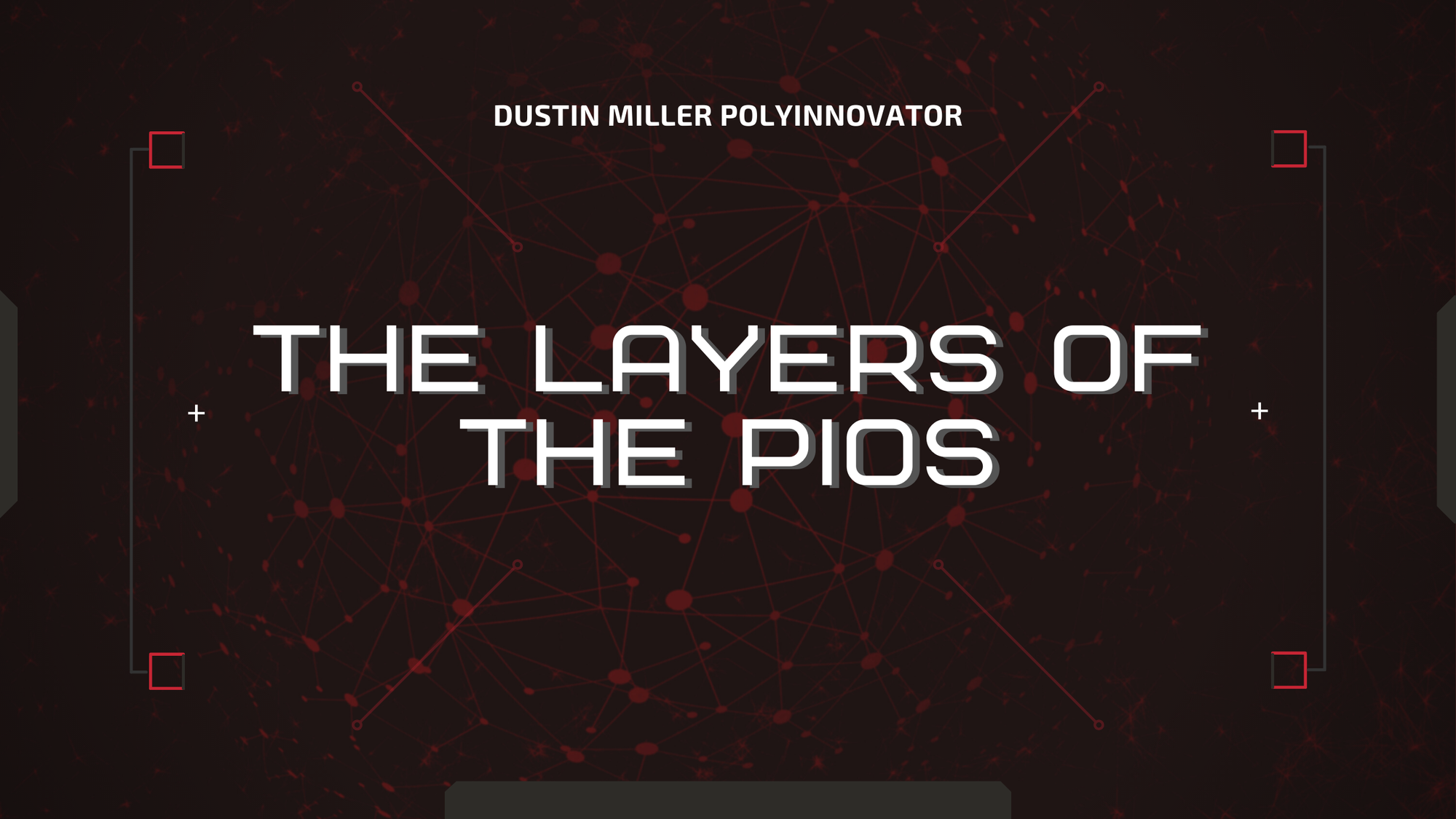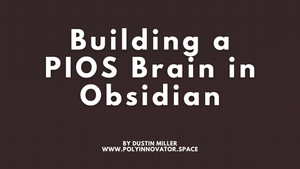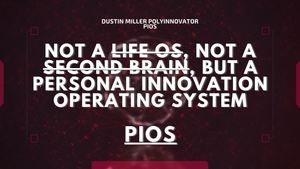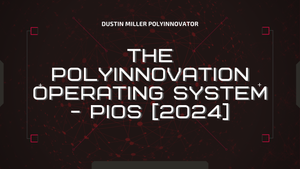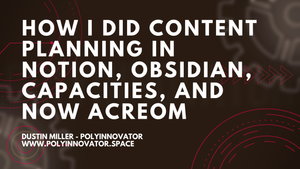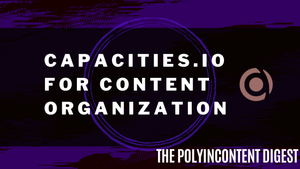The PIOS, or PolyInnovation Operating System, is a methodology framework I created to be a tool for polymaths to organize their lives.
I've always been obsessed with productivity. Given that multidisciplinary people need an even more advanced system to manage their multiple expertise. There needed to be something out there for people like me.
Now I've made some changes since the last time I talked about the various layers. After moving from one tool to 3 or more at this point. I have experienced many different applications OF THIS system. Meaning that while some things worked or translated well, there were some things that didn't. Take the Pico layer for example. I always sort of saw it as the hourly, or time tracking layer, but that wasn't useful. Given how tasks were already in Micro layer anyways.
Such as it is with any system, things are subject to change. The PIOS is no different. I even thought about changing the name to Personal Innovation Operating System, but regardless you get the idea.
Creating the Layers
While I can give you like a Notion template for you to quick start into Notion. The other tools on the market don't offer templating like that. Maybe Obsidian but I digress.
Meaning you'll have to quickly just copy down the layers when you start up with various tools.

What I really want to drive home is that this is a holistic system, more for the bigger picture. Meaning when it comes to some of the more detailed parts, like task tracking, habit tracking, or even content planning. A lot of that is going to be determined by YOU. What you need, how you learn, and how your brain works.
Some tools, like the one I am using now, Acreom, they have integrated task management options. However with things like Notion or Obsidian you're more on your own. Yes Obsd has task plugins, but in my opinion they leave a lot to be desired.
Within each layer you can flesh out how you want to interact with it. I mainly provide the templates for Supra, Macro, and Nano. Sort of the Meso layer, but that one is platform dependent.
Supra - Yearly Pre-Review
This is the one that I feel is one of the most important, and yet is still something I'm struggling to get myself to do each year.
I wonder if it is because I often work on NYE, and so I don't have a lot of energy the next day or what.
For a lot of people however it just comes down to doing it. Doing what you may ask? This is the stage of planning out your year ahead. However before you can do that, the year past needs to be reviewed.
What did you do right, what do you need to work on, and what projects are still left to do? What projects do you think this year will bring as well? How well will you balance both? These are the questions you have to ask yourself at the start of the year, then and only then can you really start to plan out your year.
Macro - Four Pillars + Ikigai Alignment
This is more philosophical in nature, but I think it is important to incorporate that into life. Understanding your Four Pillars is pretty simple. They are your mind, body, spirit, and emotions. Your ikigai is the same too, it is the culmination of your: vocation, passion, mission, and what you can provide to the world.
Following these two guiding anchors, you can align yourself towards them.
Each quarter or so you can reevaluate what you are doing, and figure out if your actions are aligned with your goals and values.
Meso - Phases + Projects + Goals
I always felt that most project management software needed an extra layer of abstraction. It is why clickup, infinity, and other tools fell off for me.
While you could switch goals and tasks with the next layer, the reason why goals are in the MESO layer is because they are bigger picture.
Goals are the objectives you want to hit in the near future, projects are how you go about hitting that goal. Tasks in the next layer fall into that as well.
Then finally the PHASES, which is probably new to you as I came up with it for myself. I had a variety of niches or areas of expertise I wanted to focus on. Not only in the next 10 years, but in life in general.
These phases are your focus for a time. Usually you'd follow pareto's principle, and go for an 80/20 split, or at least 80/10/10. With the ten and ten being past and future phases respectively. You are keeping the flame alit for the previous endeavor, while sowing the seeds for the future one. I have myself also done: 60/20/20 in the past or 33/33/34 too last year in particular.
Micro - Tasks + Habits + Systems
As they say you do not rise to the level of the challenge, but rather fall to the level of your systems. Or something like that.
Your systems are ingrained in you, while habits take more effort to do. When you form a habit long enough it can, and usually does, become a system.
Tasks you do on a daily basis, from doing work tasks to workout tasks, they form into habits if done long enough. Then when done for even longer they become systems.
Nano - Input + Output Flow
In my experience probably one of the biggest layers.
This includes your INPUT flows, such as your Resonance Inbox, as well as your Modular Degree.
As for your OUTPUT flows, those are either your personal journal, or your content creation endeavors.
The resonance inbox is sort of a catch all, like the notion web clipper, or save to rss (I had a plugin for that in obsidian), and that way you can quickly capture new ideas or links.
Then you sort it into your Modular Degree, which houses a more robust learning system. So you can tackle articles with the right intention for learning/focus.
I'm going to assume you make content, as it something that most people can, and in my opinion SHOULD do. It shows you have knowledge in a particular field.
You can take what you are learning, and distill it into your own notes and words. Finding new idea emergence as well.
Pico - Archive
Sort of circling around to being connected to every layer. As all layers fall into the yearly, but all layers also pull from the archive.
Unlike other systems like PARA, I don't see the archive as an end point. Where you don't touch anything for a while. It is more just a pool of resources, like the R in para, but things like templates or documents may go into it.
Other examples could be backups, a database, or perhaps old tasks that no longer have a home project but still need to be done.
The archive layer is a good way to keep most of your other layers/folders simpler and not as cluttered.
Creating a Supersystem, Digital Brain, or PolyInnovation System
While I don't think of this as a second brain or life os per se, they are good comparisons. This to me supersedes those methodologies.
While I haven't changed it much since the inception, the most recent version is more optimized in my opinion. I've tried it out with half a dozen tools so far, and I think it can be applied to really any of them. Unless they are like Monday or Asana, where you basically have no control over the system.
However in Notion, Acreom, Airtable, and more there are ways you can integrate the PIOS.


